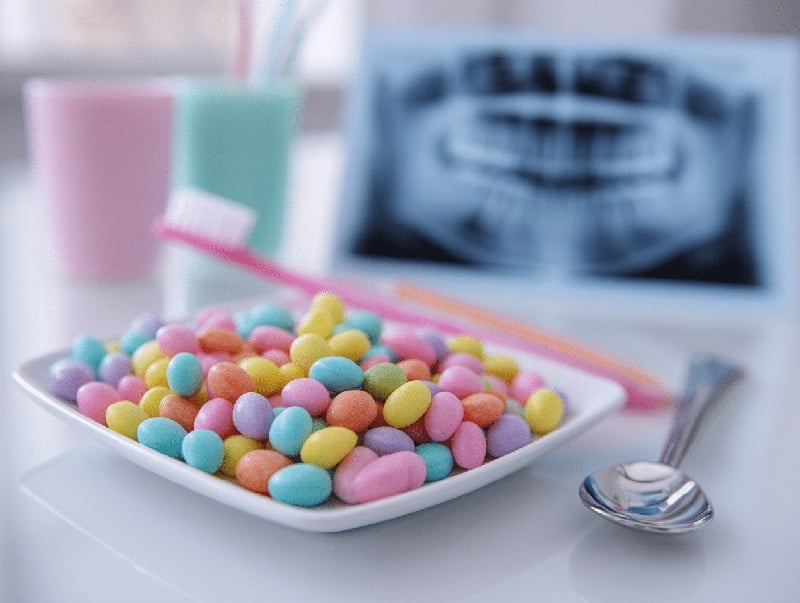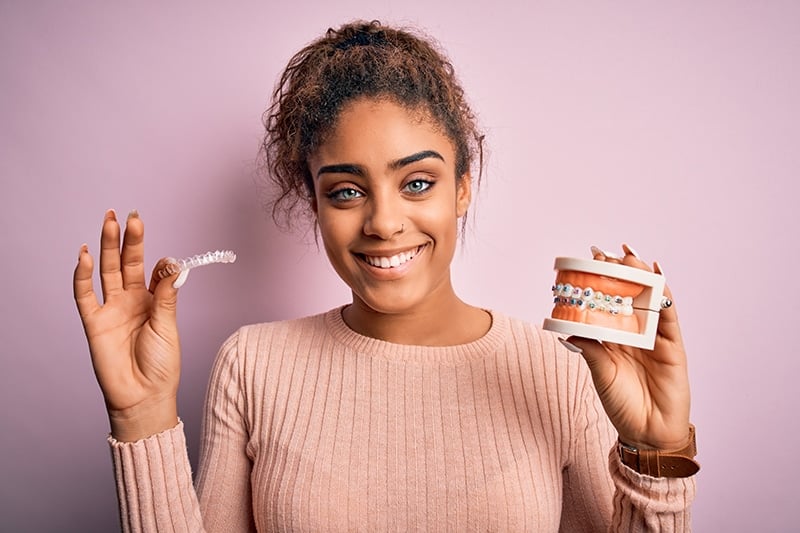🦷 Kids, Candy & Healthy Smiles
A dentist’s guide to letting kids enjoy candy while protecting their teeth
Parents always worry about whether their kids should eat candy. As a dentist, I can tell you candy and other sugar items are okay to have in moderation. You can protect your child’s teeth with cavity prevention and allow them to be a kid with all the fun experiences like candy that comes with childhood. The secret lies in which candies to choose, avoiding those that are the worst for teeth, and solid cavity prevention.
Knowing the Riskiest Foods
Dentists understand which foods pose less risk for teeth but it isn’t always obvious for parents. For instance, orange juice is a great source of Vitamin C but it is also highly concentrated in acid that can hurt tooth enamel. Apples are great for teeth but candied apples are cavity starters. Raisins have long been thought of as a candy substitute but their sugary stickiness stays on teeth.
🔬 The Science Behind Tooth Damage
The general rule is to limit sugar, acid and sticky sweets. Sugar is an essential food for mouth bacteria. Bacteria produce acids that destroy tooth enamel and produce cavities. Acid can erode enamel, cause tooth sensitivity, and contribute to tooth decay. Sticky sweets have the same impact on teeth as sugar except they sit on teeth longer and are harder to remove, making sticky sweets a higher risk food than regular candy with sugar.
Best and Worst Candies for Teeth
The general rule is candy that can easily be washed away from teeth is a better option than the sticky, gummy variety. As a dentist, I had rather my patients eat chocolate candies than other options. Chocolate easily dissolves and is swallowed quickly while hard candies remain in the mouth for longer periods. Another reason I prefer chocolate candies is that most people will drink milk or water with them. That helps flush them away from teeth. People tend to avoid drinking anything with hard candies so those sugars remain on teeth longer.
Best Candy Options
Three types of candies top the list of best candy options. They are listed below.
🚫 Sugar-Free Candies
Sugar-free candies are abundant now and contain xylitol rather than sugar. Xylitol doesn’t contribute to cavities and even has protective elements that help guard against cavities. Sugar-free gum is a great way to get a sugar fix without the sugar or the calories that come with it, making it a good choice for adults too.
🥜 Nut Candies
Nuts are abrasive and can reduce the sticky components of the candy. Nuts can help keep the candy from attaching to teeth and are healthy. They offer enough abrasion that helps prevent cavities.
🍫 Dark Chocolate
Much has been reviewed about the health components of dark chocolate compared to other types of chocolates. It has properties that fight cavities and can even harden enamel. Dark chocolate also washes away easier than other varieties.
Worst Candies
😤 Sour Candies
Sour candies, in my opinion, are the worst candy for your teeth. They are high in sugar and acid. Tooth enamel can be destroyed quickly when people eat a lot of sour candies regularly.
🍯 Sticky Candies
This refers to not just the gummy type of candies but also other types of sticky candies like caramels and taffy. This sticks to teeth for long periods, creating an all-day buffet for cavity-causing mouth bacteria.
🍭 Lollipops and Hard Candies
As a dentist, I have two problems with lollipops and hard candies. They put sugar on teeth for extended periods but can also damage teeth by causing chips and cracks. Most people will inevitably bite into the candy and that can fracture the tooth.
What Are Good Sugar Limits?
Children are suffering from consuming too much sugar. It affects their teeth and produces cavities but also contributes to obesity, diabetes, and high blood pressure. Parents should be aware that it isn’t only candy and sweets that need to be controlled but other foods containing sugar. That includes sugary drinks, jellies, syrups, cereals, and even frozen foods that can contain high sugar amounts.
The age of the child affects how much sugar they can consume. Those under 2 years old should have no added sugar. Toddlers and school-age children can have about 5 teaspoons, or 24 grams, a day.
One of the worst habits for children is to drink sugary beverages. Those should be limited to 8 ounces weekly and the count should include popsicles as they contain the same beverage in frozen form.
Teens should also have limited quantities of sugar with parents trying to keep their intake to 25 grams, or 6 teaspoons a day.
Developing Smart Candy Habits
Helping your children develop good eating and dental hygiene habits when they are young will benefit them as they grow. They will be overall healthier and have less risk of dental issues. A parental list of rules about candy eating is something parents need to think about and create that fits with their homelife. There are a few ideas to keep in mind when creating your smart candy habits.
- Include milk or water with candy consumption. This will help wash away sugars.
- Don’t include candy as a snack. Create healthy snacks like sliced apples or crackers with peanut butter instead.
- Have meals at set times. Many children will eat candy because they are hungry waiting for a meal. Eliminate that habit. Candy or sweets can come after dinner.
- Make candy a treat rather than a normal part of the day. Candy should be something extra a child gets rather than expect it as a regular food item. The same goes for things like cotton candy, taffy candied or caramel apples, or giant lollipops. It’s okay to eat them while at a fair or at a fall party, but don’t buy them at the store to stay in the home.
- Emphasize good tooth brushing and flossing habits. The earlier children get accustomed to brushing their teeth twice a day and flossing, the easier it will be to maintain healthy teeth. A good habit is to require them to brush their teeth after indulging in candy or dessert. Brushing afterward also encourages them from going back to the kitchen for another sweet snack.
- Encourage water throughout the day. Drinking water regularly will flush food debris and sugars away from teeth and protect both teeth and gums.
Dental Tips
Parents can do other things to help children keep healthy smiles and reduce the amount of sugar they consume.
- Encourage them to eat fruits and nuts rather than candy. The sweetness of fruits can satisfy a sweet tooth.
- Supervise younger children under 6 years old on toothbrushing. You may need to floss for them at first or show them how to do it.
- Look into fluoride treatments at the dental office. Fluoride treatments add protection to teeth.
- Help them stop thumb-sucking or putting objects in their mouth. Ask us ways to stop or prevent this behaviour.
- Keep up to date on their dental appointments. Children who get to know their dentist young will trust them more and keep up the habit.
🌟 Ready for a Fun Dental Visit?
At Kids Dental Studio, we make dental visits exciting with ice cream, games, and prizes! Let’s help your child develop healthy habits while having a blast. Schedule their next adventure with us!
❓ FAQs
1. Is chocolate better than gummies for oral health?
Yes, eating chocolate is a better option than gummies. The best chocolate for oral health is dark chocolate and avoid chocolate that combines sticky caramel, marshmallows, or other similar items.
2. How soon should kids brush after eating candy?
Parents may want kids to brush immediately but they should wait 30 minutes after eating candy to brush. Their saliva works to remineralize teeth after eating and you need to let it do its job first.
3. Should kids floss after eating lollipops?
Yes, kids should brush and floss after eating lollipops because these are sticky candies that can get stuck in teeth crevices and between teeth.
4. When should I start brushing my child’s teeth?
Start brushing your child’s teeth as the baby teeth come in. However, you should start oral health care routines before that even before they are teething. You can do that by rubbing a soft cool cloth across their gums. It will relieve pain while teething and get them accustomed to putting an object against their teeth so they won’t fight you during first brushings.



